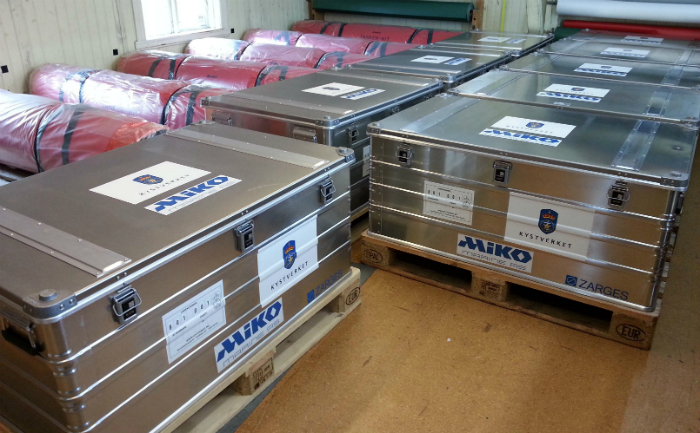-PRESS RELEASE-
The Norwegian Coastal Administration (NCA) has received a significant high value delivery of 15 emergency marine repair patch kits from Miko Marine AS. These can be used on any type of vessel in the event of hull damage and are routinely carried aboard all NCA patrol boats so they can provide practical assistance in an emergency. The patches will be carried as Salvage Kits containing a variety of sizes of magnetic and flexible Kevlar-reinforced fabric patches.
The magnetic patches are generally used for smaller and less complicated sealing emergencies while the non-magnetic Kevlar-reinforced fabric patches are used for closing-off larger and more complex instances of hull damage. If required, either type of patch can be manufactured and supplied in any size up to 50-metres x 10-metres. This makes them a fast and reliable means of sealing hull damage that can be used as a quicker and more practical alternative to welding when re-floating a damaged vessel. The patches can also be used to seal sunken vessels to prevent the escape of trapped oil that might be released if the wreck should move some time in the future.
All NCA coastal patrol boats have been equipped with kits of Miko patches for a number of years. In this time they have been used to prevent the sinking or capsize of a significant number of vessels in Norwegian waters. Some notable examples include the occasion in 2010 when a magnetic patch was used to secure a leak in a nuclear fuel carrier. The in-flow of water could not be stopped from the inside and the ship was in real danger sinking but a magnetic patch provided by a NCA patrol boat sealed the leak and enabled the ship to be escorted into port for permanent repair.
A year earlier in the far north of Norway a family-owned trawler was in port unloading its catch when it was extensively damaged by another fishing vessel. It was in real danger of capsizing so a flexible Miko patch was fixed over the hull damage by using a high-power underwater stapling tool to seal its edge. This prompt action enabled most of the catch to be saved and after some internal reinforcements to the hull frames, Coastal Administration inspectors considered the flexible patch to be so secure that they authorised the boat to resume its fishing in Arctic waters for the final weeks of the season before docking for repair.
Nicolai Michelsen, managing director of Oslo-based Miko Marine, has no doubts about the benefits that can be gained from using his company’s products. “They have been used to save ships and offshore platforms from sinking on numerous occasions,” he said, “and afterwards people invariably remark upon how the cost of the patch is so insignificant compared with the costs of cleaning-up an environmental disaster that would have occurred had it not been available. It is, however, vital for the patch to be applied quickly and when NCA patrol boats are equipped with Salvage Kits a rescue is often possible. They are also carried by every ship in the French navy but our experience forces us to believe that certain types of vessel should be required to carry them as a matter of routine. Ships with a high potential for pollution that are far from any rescue infrastructure and vessels operating in ice are obvious candidates and we believe that the insurance industry could start thinking about how it might offer more attractive premiums to certain types of vessels equipped with emergency repair patches,” said Michelsen.


